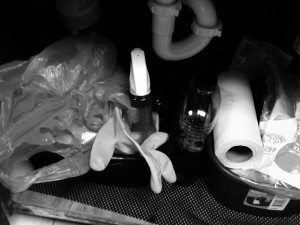by Heidi Copeland | Mar 24, 2015

Spring cleaning of one’s home is a tradition dating back centuries that is tied to the vernal equinox – the first day of spring. At the spring equinox, days are approximately 12 hours long with day length increasing as the season progresses. In many cultures this longer, lighter, warmer day is often a cause for celebration! And who could even think about celebrating a longer, lovelier day without a clean home?
The kitchen is a great place to start! You can protect yourself by preventing the spread of germs where food is prepared. However, the terms clean, sanitize and disinfect are often used interchangeably which can cause confusion. Best practices based upon current research state that cleaning and sanitizing is multi-step process. And even though surfaces look visibly clean, they may still be contaminated with microorganisms (infectious fungi, bacteria and viruses).
Cleaning is the removal of dirt from food preparation surfaces. These can be counters, cutting boards, dishes knives, utensils pots and pans – even your refrigerator.
- Wash surface with soap and warm water
- Rinse with clean water
- Air dry or dry with a clean disposable towel
Sanitizing reduces germs on inanimate – nonliving surfaces.
- Wash surface with soap and warm water using appropriate cleaning agents and equipment. Detergents can penetrate soil quickly whereas solvent, acid or abrasive cleaners may be needed for deep cleaning. The friction of cleaning — often with soap and water — removes most surface germs, which is adequate for most household surfaces.
- Rinse with clean water
- Air dry or dry with a clean disposable towel
Disinfecting destroys or inactivates most germs on inanimate surfaces.
- Wash surface with soap and warm water
- Rinse with clean water
- Disinfecting is not appropriate in all cases. However, it’s a good idea to get in the routine of disinfecting countertops, door and cabinet handles, and sink and sink faucets as these places are used frequently- think where dirt and guck can collect!
- Air dry or dry with a clean disposable towel
Also remember to disinfect dishcloths – often. Launder dishcloths frequently using the hot water cycle of the washing machine. Be sure to dry cloths thoroughly. These items can harbor bacteria and when wet, promote bacterial growth. Also, consider using disposable towels to clean up surfaces.
And don’t forget your kitchen sink drain and disposal. Once or twice a week clean, sanitize and disinfect.
Bathroom surfaces can be of critical concern. Surfaces closest to the toilet bowl – seat, cistern and nearby walls and shelving are most affected. When cleaning and disinfecting bathroom surfaces it is important to understand fecal matter is especially a huge matter of concern!
Then there are our general housekeeping surfaces, floors, walls, and furniture, which are low–touch surfaces that require low-level of disinfections. Cleaning these surfaces frequently with a bit of detergent or a low-level disinfectant designed for general housekeeping can decrease the level of contamination. General procedures should be followed. Remove dirt form surfaces (dust, vacuum or sweep) sanitize or disinfect, allow surfaces to air dry.
Thorough cleaning of all surfaces is important to reduce the spread of pathogens. High-touch surfaces, surfaces that are handled frequently, throughout the day, by numerous people, need cleaning and disinfecting. These surfaces can include doorknobs, light switches, phones, keyboards etc. that can become contaminated by objects such an inadequately cleaned rag, sponges or even improperly washed hands.
Cleaning regularly prevents the build-up of materials that can carry pathogens and support their growth. Some pathogens, viruses especially, can have a long shelf life and can stay on surfaces if they are not properly cleaned, sanitized or disinfected.
Take a look at The University of Florida IFAS EDIS publication explaining the use of common household products to use effectively as sanitizers. Also remember, it is critical to read and follow the safety instructions on any product you use.
http://edis.ifas.ufl.edu/pdffiles/FY/FY128000.pdf
http://www2.epa.gov/saferchoice
Heidi Copeland Extension Agent II Family and Consumer Sciences
615 Paul Russell Road Tallahassee, FL 32301-7060 850/606-5203

by Angela Hinkle | Mar 13, 2015

UFOs in Your Freezer
Does your kitchen freezer resemble an archaeological dig in an iceberg? Do you ever see what you think is what you’re looking for in the very back? As you reach for it, half of everything else falls out onto your kitchen floor? UFOs (Unidentified Frozen Objects) end up everywhere. Your reaction may be something like, “*#@&!”
This may be a sign that it’s time to organize your freezer. “Are you kidding me? Who has time for that?,”’ you may ask. You might even roll your eyes.
Here are a few tips that may help:
- Clean it out and when in doubt, throw it out.
Start with the hardest part first – trust me, it gets much easier after you’ve completed this step. Go through all the contents of your freezer and throw out what is freezer-burned or otherwise unusable. If you really have no idea if it’s animal, mineral, or vegetable, or how long it’s been in your freezer, it’s time to toss.
If you’ll take a quick moment to label and date the food before you put it in the freezer, you’ll save your sanity later by avoiding guess work. (A friend told me she pulled the plastic tub of fundraiser cookie dough out of the freezer as a treat for her kids. What a surprise to be treated instead to vegetable stew.) Label using wax crayons, pencil, or marker pens on stickers or tape that can stay put in freezing temperatures. And yes, if you are so inclined, there are apps for labeling. By the way, the sniff test is usually useless, since most frozen foods won’t have much of an aroma.
- Freeze in useable portions.
Congratulations! You saved money buying the chicken in that family-sized pack. Keep food safe and manageable by individually wrapping pieces, then freezing in a large, labeled, plastic zip-type bag. Then you only take out the amount you want. You may lose more money than the original savings if you have to thaw out and possibly throw out a gigantic clump of chicken because you only wanted enough for two. Smaller packages also freeze and thaw faster, which saves you time.
Pancakes, berries, broths, meats, nuts, chilies and stews, flour, shrimp, and fish are good choices for freezing. These foods are structurally sound enough to survive the freezer. On the other hand, you’ll want to avoid freezing high-moisture fruits and vegetables like lettuce and watermelon, yogurt, and fried foods. Their textures and appearance tend to turn to, well, yuck.
- Choose the best containers.
We need air to breath, not to circulate around our frozen foods. Air circulating around frozen food can lead to freezer burn – which often makes the food dry and tough. Find containers close to the size of the food you want to freeze. Also, freezing food flat in plastic zipper bags makes them easy to stack.
Remembering to use these tips should help de-stress your life … at least a little. So the next time you’re asked, “What’s for dinner?,” your reply won’t have to be, “We’re having the UFO that fell on my foot.”
For more information on freezing foods, contact your local UF/IFAS Extension Office at http://directory.ifas.ufl.edu/Dir/searchdir?pageID=3&pl=05 and check out these UF/IFAS publications on freezing fruits, http://edis.ifas.ufl.edu/pdffiles/FY/FY72000.pdf, and freezing vegetables, http://edis.ifas.ufl.edu/pdffiles/FY/FY71900.pdf
by Marjorie Moore | Feb 11, 2015

Photo taken by: Marjorie Moore
February is heart month, a time to consider including foods in your diet that will benefit your heart. Much has been in the media during the last few years about the positive heart health benefits of blueberries, red wine and dark chocolate. According to research, the compounds responsible for the positive effects are called flavonoids, which occur naturally in food.
Flavonoids that promote heart health fall into six major categories. One category is flavonols and those are found in small amounts in some fruits and vegetables. This is another good reason to consume these foods. An example of a good food source for flavonols is one cup of kale, which contains 62 milligrams of flavonols.
Another category, anthocyanindins, gives fruits and vegetables their red, blue or purple color and protects the body from free radicals. To get the most benefit from anthocyanindins, it is best to consume fruits and vegetables in their raw or fresh state. One cup of fresh cranberries contain 101 milligrams of anthocyanindins. Cranberry sauce has a much lower amount of anthocyanindins.
To learn more about flavonols and anthocyanindins and the remaining four flavonoids, click on this link http://edis.ifas.ufl.edu/pdffiles/FS/FS24400.pdf
Source: Facts about Flavonoids, EDIS Publication FSHN14-04
by Ginny Hinton | Jan 30, 2015

There’s a new law in Florida – and although it’s far from comprehensive, it’s designed to better protect our kids. As of January 1, 2015, Florida law requires that all children riding in vehicles must use a safety seat until their 6th birthday. This means that kids who are 4- or 5-years-old and were previously restrained using just a seat belt must now ride in a car seat or booster seat.
Although much of the publicity about the new law also has reinforced the guideline that children under age 13 are much safer in the back seat, the law itself applies only to children who are not yet six. The law is not a “booster seat” law, because children under age 6 are still safer in a 5-point harness. Once your child is at least 4-years-old, weighs at least 40 pounds, and can sit in position for an entire car trip, you may make the decision to move that child to a booster seat. The fact remains, however, that the child is still much safer in a 5-point harness until he/she reaches the upper height or weight limit of that seat (typically 40-65 pounds). Even though your child may beg to differ, keeping him/her in a harnessed seat longer is one of the best gifts you can offer as a parent!
Want to make sure you’re using the best type of restraint for your child? You can find a nationally certified child passenger safety technician near you at http://cert.safekids.org. Click on “Find a Tech” and search by location.
by Elizabeth | Jan 17, 2015
 The Merriam-Webster Dictionary defines “resolution” as “the act of finding an answer or solution to a conflict, problem, etc.; the act of resolving something.” Now that 2015 is here, what are you seeking to resolve this year?
The Merriam-Webster Dictionary defines “resolution” as “the act of finding an answer or solution to a conflict, problem, etc.; the act of resolving something.” Now that 2015 is here, what are you seeking to resolve this year?
If you read Living Well in the Panhandle articles, you probably have noticed a theme. The theme is information on Living Well – not just for one day or one month but for the whole year. With that in mind, what do you resolve to do this year to live well? While identifying your resolutions, it is important to note that, unless your chosen resolution becomes a habit, you may fail to achieve it. However, regardless of what your resolution is this year, here are a few things to consider to help you with your resolve.
Join an organization that supports people with the same resolve. For instance, many people resolve to save more money each year. From personal experience, it is tough to change spending habits without moral support. However, organizations like America Saves motivate people who want to save for different goals. Pledge to save during America Saves Week – February 23- 28 (www.americasaves.org) or any time before then. This is one avenue many people across the country have used to stick with their resolution to save. The resolution becomes a habit because, on the America Saves website (www.americasaves.org), you can find motivation from other savers or prospective savers like yourself. You also can sign up to receive a free newsletter with information on how to maximize your effort.
Judging by the number of weight loss commercials in the media, the other most common resolutions include eating right, exercising, and losing weight. There are several web sites you can visit that provide unbiased information as you work your way toward living well. At Small Steps to Health and Wealth (http://njaes.rutgers.edu/sshw/), you can sign up for the Online Challenge that will help you make small daily changes to improve your health and personal finances.
A good resolution should focus on improving one’s life. That said, choose to read Living Well in the Panhandle and live well not just for a day or a month but for the rest of your life. For more information on Living Well in the Panhandle, contact your local UF/ IFAS Extension Agent. Happy New Year!
by Marjorie Moore | Nov 22, 2014
 Eat, drink, be happy and be healthy this holiday season. My favorite holidays are just around the corner. It is an exciting time to be with family and friends. There is usually lots of food that may come with lots of calories and carbohydrates. Are you wondering how to survive this holiday season without adding more calories and carbohydrates to your diet?
Eat, drink, be happy and be healthy this holiday season. My favorite holidays are just around the corner. It is an exciting time to be with family and friends. There is usually lots of food that may come with lots of calories and carbohydrates. Are you wondering how to survive this holiday season without adding more calories and carbohydrates to your diet?
The first thing to keep in mind is to plan your meals to help keep your diabetes management on track. Persons with diabetes should space out their carbohydrate intake throughout the day. Fruits, starchy vegetables, dairy foods, and grain foods all contain carbohydrates. Eating the right amount of carbohydrates throughout the day will help you control your blood glucose levels. The Idaho Plate method of meal planning is one of many tools to help control carbohydrates while recommending at least one-half your plate consist of vegetables. More information on the Idaho Plate can be found at http://edis.ifas.ufl.edu/fy334 .
If you going to a party or eating at a friend or relative’s home and the meal time is around your normal dinner time, try to eat the same amount of carbohydrate that you normally would eat. You may ask your host if you can bring a covered dish. If so, take your favorite low carbohydrate dish to share.
Avoid or limit the amount of sugary drinks like soda, fruit punch or drinks, sweet tea and eggnog. These drinks raises blood glucose and can provide lots of calories in one serving. For example, one cup of fruit punch contains 100 calories or more and at least 30 grams of carbohydrate; and, one cup of eggnog may have as many as 344 calories and more than 34 grams of carbohydrates. A much better choice is to choose diet or other low-calorie drinks that are available in several flavors. Remember, water is a much healthier choice and has no calories.
Fill up on salad first. Filling up on salad or other raw veggies will fill you up without lots of calories.
Don’t forget to focus on conversation. Make an effort to meet new friends or circulate with those you know instead of eyeing the food.
Stay active this holiday season. Put yourself on your gift list by treating yourself to a personal trainer, fitness class series or membership to a gym.
Learn more about how you can enjoy eating healthy as a diabetic this holiday season by contacting your local UF/IFAS Extension Office .







